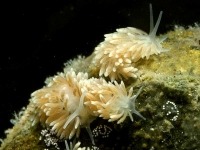
(Photo: Bernard E. Picton)
A Sea Slug
Cuthona nana
Small sea slug, mainly pink in colour. Adults up to 28 millimetres in length. Body translucent white with many pinkish projections (cerrata). The cerrata have white tips. Two tentacles on head (rhinophores) with white tips.
Authority
Alder & Hancock, 1842
Classification Details
Phylum: Mollusca (molluscs); Class: Gastropoda (gastropod molluscs, or snails and slugs).
Habitat
Found on hermit crab shells on which its food, the hydroid Hydractinia echinata, grows. Found on the Atlantic coast of North America from New Hampshire to New Brunswick. Also in Europe (British Isles, Northern France, Scandinavia, Greenland).
Diet
Predator. Feeds on the hydroid Hydractinia echinata which often grows on the shells of hermit crabs. Cuthona nana doesn't kill the hydroid colonies it preys on but crops some of the feeding polyps. The colony can grow these back. A large adult can eat 200 to 500 polyps in 24 hours.
Reproduction
Hermaphrodite - individuals are both male and female. Adults leave their hydroid colony to lay a coiled string of egg capsules on colonies of Hydractinia echinata. Each mass contains 300 to 600 eggs. The eggs hatch after 18 to 21 days. The veliger larvae attach to the bottom and crawl. After one or two days they change into a juvenile sea slug. They wait in the open to hitch a lift on a passing hydroid covered hermit crab. Juveniles reach maturity and reproduce within four months, so there are three to four generations of nudibranchs within a year.
Fun Facts
Unlike other sea slugs Cuthona nana is immune to the stinging cells of its prey. It can crawl over the hydroid with no ill effects whereas if you drop other sea slugs into a colony, they die.
Individuals feeding on female colonies of their prey, the hydroid Hydractinia echinata, are usually darker than those from male colonies. The male hydroid reproductive structures are colourless, while the female ones are pink. The sea slug absorbs the colour of what it has eaten.
References
de Kluijver MJ, Ingalsuo SS, de Bruyne RH (2000) Cuthona nana. In: Mollusca of the North Sea. http://species-identification.org/species.php?species_group=mollusca&id=642 Accessed online 20 November 2020. Folino, NC (1989) The dynamics of a nudibranch-hydroid predator-prey association: Cuthona nana and Hydractinia echinata. PhD Thesis. University of New Hampshire. Available from https://scholars.unh.edu/dissertation/1573. Harris LG, Wright LW, Rivest BR (1975) Observations on the occurrence and biology of the aeolid nudibranch Cuthona nana in New England waters. Veliger 17:264-268. Picton BE and Morrow CC (2016). Cuthona nana (Alder & Hancock, 1842). [In] Encyclopedia of Marine Life of Britain and Ireland. http://www.habitas.org.uk/marinelife/species.asp?item=W14710 Accessed online 20 November 2020. Rivest BR (1978) Development of the eolid nudibranch Cuthona nana (Alder and Hancock, 1842), and its relationship with a hydroid and hermit crab. Biological Bulletin 154: 157–175.

